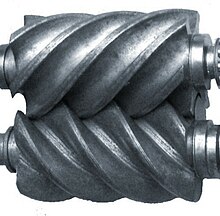Rotary-screw compressor Working Principle
Superchargers
The twin-screw type supercharger is a positive displacement type device that operates by pushing air through a pair of meshing close-tolerance screws similar to a set of worm gears. Twin-screw superchargers are also known as Lysholm superchargers (or compressors) after their inventor, Alf Lysholm.[6] Each rotor is radially symmetrical, but laterally asymmetric. By comparison, conventional "Roots" type blowers have either identical rotors (with straight rotors) or mirror-image rotors (with helixed rotors). The Whipple-manufactured male rotor has three lobes, the female five lobes. The Kenne-Bell male rotor has four lobes, the female six lobes. Females in some earlier designs had four. By comparison, Roots blowers always have the same number of lobes on both rotors, typically 2, 3 or 4. The working area is the inter-lobe volume between the male and female rotors. It’s larger at the intake end, and decreases along the length of the rotors until the exhaust port. This change in volume is the compression. The intake charge is drawn in at the end of the rotors in the large clearance between the male and female lobes. At the intake end the male lobe is much smaller than its female counterpart, but the relative sizes reverse proportions along the lengths of both rotors (the male becomes larger and the female smaller) until (tangential to the discharge port) the clearance space between each pair of lobes is much smaller. This reduction in volume causes compression of the charge before being presented to the output manifold.
Comparative advantages
The rotary screw compressor has low leakage levels and low parasitic losses vs. Roots type. The supercharger is typically driven directly from the engine's crankshaft via a belt or gear drive. Unlike the Roots type supercharger, the twin-screw exhibits internal compression which is the ability of the device to compress air within the housing as it is moved through the device instead of relying upon resistance to flow downstream of the discharge to establish an increase of pressure.[7]
The requirement of high-precision computer-controlled manufacturing techniques makes the screw type supercharger a more expensive alternative to other forms of available forced induction. With later technology, manufacturing cost has been lowered while performance increased.
All supercharger types benefit from the use of an intercooler to reduce heat produced during pumping and compression.
A clear example of the technology applied by the twin-screw in companies like Ford, Mazda, Mercedes and Mercury Marine can also demonstrate the effectiveness of the twin screw. While some centrifugal superchargers are consistent and reliable, they typically do not produce full boost until near peak engine rpm, while positive displacement superchargers such as Roots type superchargers and twin-screw types offer more immediate boost.


Comments
Post a Comment